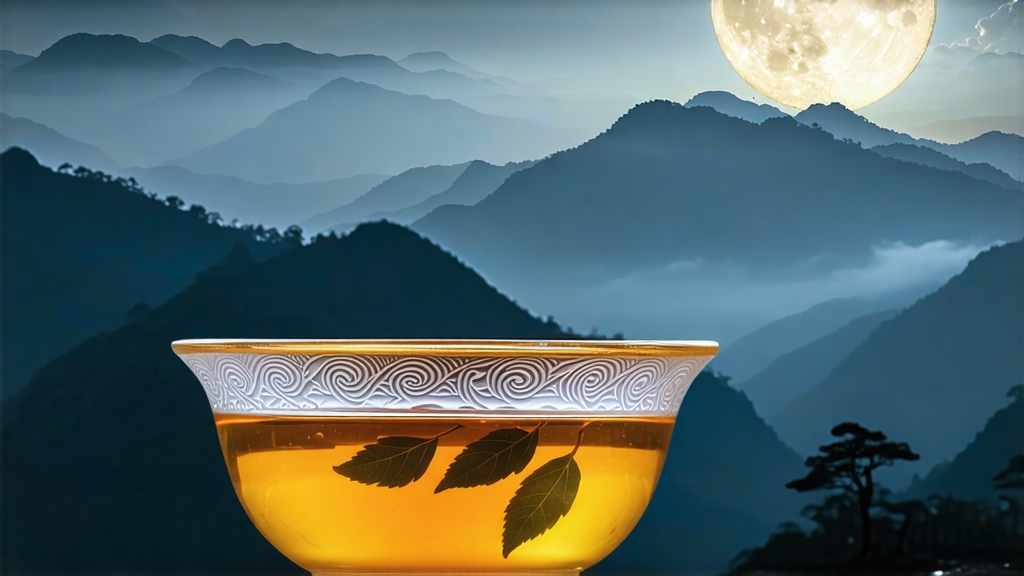
Tucked away in the subtropical highlands of southern Yunnan, where the Mekong River bends like a silver ribbon beneath jade-green terraces, a tea is picked only when the moon hangs at its roundest. Farmers call it Yue Guang Bai—literally “White Moonlight”—a name that sounds more like poetry than agriculture. To international drinkers the phrase is still unfamiliar, yet within the sprawling family of Chinese white teas this quiet cousin of Fujian’s celebrated Silver Needle and White Peony is quietly rewriting the definition of what “white” can taste like. Its story begins not in the coastal province that invented white tea, but on the ancient tea forests of Yunnan, where 300-year-old Da Ye (broad-leaf) assamica trees have watched dynasties rise and fall.
Historical whispers
Unlike the well-documented tribute teas of the Song court, Yue Guang Bai has no imperial edicts to boast of. The earliest written reference appears only in 2003, in a ledger kept by a small factory in Jinggu County. Local legend, however, places its birth in 1987, when a tea scientist named Mr. Duan tried to rescue a batch of frost-bitten spring buds by moving them into the shade of his courtyard after sunset. The leaves, still warm from afternoon sun, continued to breathe in the cool night air, developing a honeyed aroma no one had encountered in standard white-tea production. Whether myth or memory, the tale captures the essential romance of the tea: it is finished not by heat, but by moonlight.
From forest to basket: the cultivar
Yue Guang Bai is almost always made from the Da Ye cultivar, the same genetic stock that gives Pu-erh its gutsy character. Yet the difference lies in the plucking standard. Only the bud and the immediate first leaf are taken, and only between the Qingming and Grain Rain periods when the moon is waxing toward full. The broad-leaf buds are chunkier than their Fujian counterparts, resembling tiny spears dipped in pewter, and they carry a natural down that looks like powdered starlight.
Crafting under a cool sky
Traditional white-tea doctrine calls for two steps: withering and drying. Yue Guang Bai adds a third dimension—time of day. After picking, the leaves are spread on bamboo trays set on raised racks inside open-walled sheds. Withering begins in late afternoon sun (28–30 °C), but the critical phase occurs after dusk, when temperature drops to 18–20 °C and humidity climbs to 85 %. Under this lunar “air-condition” the leaf cells remain alive, continuing low-grade respiration that converts grassy aldehydes into floral lactones. Around midnight the trays are gently flipped by hand; by dawn the leaves have lost 70 % of their moisture without ever tasting stale. Finally, they are transferred to a low-temperature dehydrator (40 °C) for 30 minutes—just enough to lock in the bouquet without caramelising sugars. The result is a curled, two-tone leaf: silvery on the bud side, charcoal-black on the leaf back, as if dipped in ink and rolled in stardust.
Grades and shapes
Commercial lots are sold under three informal grades. “Needle Moon” consists of 90 % buds and steeps the lightest, with white peach and water-chestnut notes. “One Leaf Moon” balances bud and leaf, yielding a thicker body reminiscent of warm bamboo sap. “Midnight Curl” is the most affordable, containing up to 30 % second leaves; it surprises newcomers with a sweet-potato velvet finish that echoes Taiwanese black teas. All grades share a common signature: a lingering coolness on the palate that Chinese drinkers compare to “drinking moonlight itself.”
Water, leaf, and patience: brewing protocols
Because Yue Guang Bai is sun-withered rather than pan-fired, its cell walls remain fragile. Aggressive water will shred the flavour. Start with mountain-spring water brought to 85 °C; anything hotter flattens the orchid top notes. For a 150 ml gaiwan, use 4 g of leaf—roughly two heaped tablespoons. Rinse briefly (three seconds) to wake the buds, then steep 20 s, 25 s, 35 s, 50 s, 90 s, adding ten seconds for each subsequent infusion. The first liquor is the colour of pale chardonnay; by the fifth